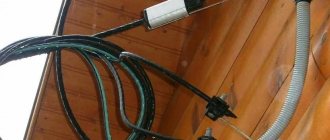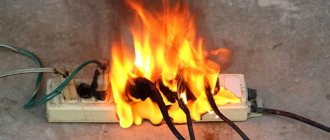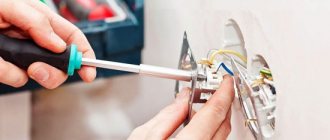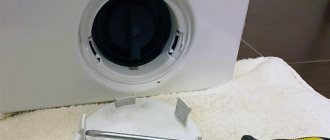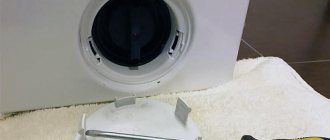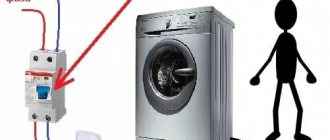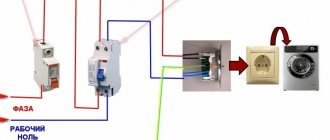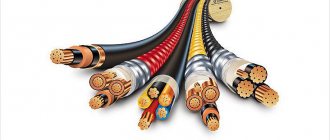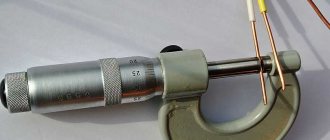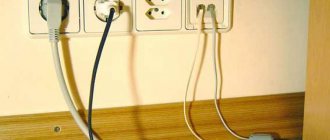Choosing an automatic washing machine is a responsible matter, but it is equally important to correctly connect it to the internal communications. Particular attention should be paid to the electrical part. You need to choose a reliable socket, install it correctly, select the correct wire cross-section for the washing machine and perform the installation efficiently. Most often, wiring is done during a major renovation of an apartment, but if necessary, you can lay a new cable immediately before installing new household appliances.
Features of connecting the washing machine to the electrical network
Like any other electrical appliance, a washing machine consumes electricity. Moreover, it belongs to the class of high-power consumers, as a result of which the connection must be made in strict compliance with a number of rules.
It is strictly forbidden to connect the washing machine:
- to a socket with visible damage;
- to electrical wiring made with a cable of insufficient cross-section;
- through extension cords or adapters;
- using a tee to a socket with a high-power electrical appliance already connected.
To protect the washing machine from possible breakdown, and yourself from a serious accident, you should select a separate outlet for connection, designed to operate in conditions of high humidity. The connection should be made using a large cross-section wire, and it should not come out of the nearest junction box, but directly from the panel. Otherwise, when the engine is turned on at maximum speed, the wire insulation may melt, which in turn can cause a fire.
If the owner plans to install several powerful devices in one room, for example, a washing machine with a dryer and a dishwasher, it is not necessary to lay a separate wire for each of them; it is enough to lay a copper wire, the cross-section of which is taken “with a reserve”, and wire it into two sockets in place.
Grounding
The place to install the unit is most often chosen in the bathroom. Working in conditions of high humidity automatically increases operating risks. Therefore, the latest models are equipped with Class 1 protection against electric shock. This is ensured by protective earthing.
Read also: Can we survive without the Internet?
If the house you live in was recently built, then no additional steps are taken to ground the machine. Such houses already have grounding and modern wiring with a built-in third wire.
In old houses, the washing machine is grounded from the electrical panel. A neutral wire is attached to it, which will act as grounding. The zero is bifurcated and special tires are fixed to both the neutral wire and the ground. From these buses they run wiring to the car and install a new outlet designed for grounding. In this way, they compensate for the lack of a third wire in old-style houses.
Selecting a wire to connect a washing machine
The reliability and durability of electrical wiring directly depends on the quality of its components. First of all, this applies to the wire. The main criteria for its selection are as follows:
- number of cores;
- conductor material;
- cross-section of the current-carrying conductor.
According to technical regulations, a modern automatic washing machine must be grounded. To do this, it is equipped with a plug with special contacts, therefore, you will need a three-core wire and a corresponding socket.
Aluminum and copper wire are available for sale. It is not recommended to use aluminum to power large household appliances; the optimal choice is copper.
Last, but not least, the characteristic of the wire is its cross-section. The value of this parameter is selected based on the power of the connected device. It’s easy to find a correspondence table on the Internet; in general, for a standard household model with a power of 2.5 kW, a copper wire with a core cross-section of 2.0-2.5 mm2 is perfect.
The problematic proximity of copper and aluminum
Most older residential buildings typically use aluminum wire as the main wiring. Its direct connection to a copper cable is not allowed, because when interacting, these metals enter into a chemical reaction, as a result of which the contact point is oxidized, forming a dielectric film on the surface of the conductor. Such a connection quickly begins to heat up and, regardless of the thickness of the cross-section of the wire for the washing machine, especially under high load, inevitably leads to burnout of the contact pair. This can lead to equipment failure and even a fire. To avoid such a situation, specialized connecting clamps must be used to interface copper and aluminum conductors.
It is also now possible to calculate what wire cross-section is needed for a washing machine when using an aluminum three-core cable for power supply. With a declared load of 2.2 kW, its cross-section must be at least 3 mm2 for each thread.
Additional wiring accessories
Having decided on the wire parameters, you can move on to auxiliary devices, without which it is impossible to connect the washing machine. Required:
- powerful socket;
- socket box with fasteners;
- terminals for connecting wires;
- residual current device (automatic);
- cable channel (in case of open installation).
Particular attention should be paid to the choice of outlet. First of all, it must be designed for a power exceeding the consumption of the washing machine, otherwise the material may melt, contact deterioration, failure, and possibly a fire. We also must not forget that the washing machine is usually installed in the bathroom; it is operated in conditions of high humidity, therefore, the outlet must be waterproof.
Other parts must be selected based on their quality. Even something as simple at first glance as a socket box significantly affects the durability and reliability of the wiring. There is no need to buy cheap plastic products; if heated, they will become a source of a pungent odor and may catch fire if the temperature rises too high. The same applies to the cable channel.
Despite the fact that automatic protection devices are required to be installed at the entrance to the apartment, it is worth spending a little money and installing a separate machine on the line going to the washing machine. It will work in the event of an excessively increased load on the wiring, prevent an accident, and other consumers in the apartment will not be de-energized.
Residual current device
A residual current device (RCD) is designed to protect a person from electric shock in the event of breakdowns or contact with live parts of an electrical appliance, as well as to prevent short circuits and fires.
As a rule, an RCD for a washing machine is paired with a machine. But you can install one automatic device instead of these two devices; it will protect both people and equipment.
When choosing an RCD for a washing machine, they are guided by the power of the device. Most models consume about 2 kW, which exceeds the 10 A rating. Therefore, an automatic or automatic machine chooses one that operates at a current greater than 10 A. This is a 16 A device.
Planning and marking
Before you get down to business, you need to choose the optimal location to install the outlet. It should be located in close proximity to the machine, but the distance to the shield must also be taken into account. Do not forget that the further the shield is, the more wire will be required, in addition, the more work on gating and subsequent sealing of the channel will have to be done.
The installation location of the socket, as well as the wire route, is marked with a marker directly on the wall. When planning a route, you must remember that the wire must run either strictly vertically or strictly horizontally. Violation of this rule can cause an accident; not knowing where the wiring is laid, you can drive a nail or tighten a screw extremely unsuccessfully.
Having finished marking, it is worth checking everything again, and at the same time making sure that there is a sufficient amount of wire and its cross-section is correctly selected. It is important to understand here that high-quality wiring for a washing machine is continuous wiring. There should be no connections or twists in the channel - these are potential fire points.
Repair time
When transferring the TST for repair, an agreement is drawn up indicating the time frame within which the deficiencies must be eliminated. If this period is not established, the time for restoration work cannot exceed 45 days (Part 1 of Article 20 of the Civil Code). If during the repair it turns out that the repair cannot be completed within the agreed time frame, the parties may enter into an additional agreement establishing a new time frame.
It is important to consider here that the lack of spare parts, equipment and other parts necessary for repairs is not a reason to increase its time. If we are talking about a durable product, the seller is obliged to provide a similar product for the period of repair (Part 2 of Art.
20 ZPPP). This is done strictly at the buyer’s request within 3 days after its presentation
If we are talking about a durable product, the seller is obliged to provide a similar product for the period of repair (Part 2 of Article 20 of the Labor Code). This is done strictly at the buyer’s request within 3 days after its presentation.
The warranty period during the repair period is suspended and resumed after the goods are delivered to the buyer. If components have been replaced, a new warranty period is established for them (Part 4, Article 20 of the Labor Code).
If the item breaks again
If there is a repeated breakdown, you can demand to cancel the sales contract and return the money, as well as exchange the product for a similar or different one with a recalculation of the cost.
Tools and consumables
The list of tools that will be required to lay the wire to the washing machine is individual and directly depends on the material of the walls. In limestone or a thick layer of plaster, you can chisel a channel with a “classic” hammer and chisel; in the case of monolithic reinforced concrete, you cannot do without a grinder. In general, you should prepare the following for work:
- electric drill and concrete drills;
- grinder with a disc for stone;
- sharp mounting knife;
- wire cutters and pliers;
- several screwdrivers;
- indicator screwdriver.
Consumables, namely a copper wire of the required cross-section and a socket, have already been purchased, as well as everything that is needed for installation, but it’s worth stocking up on electrical tape just in case. Even if twisting is not planned, but with its help you can quickly fix the wire in the right place. A tube of regular silicone sealant wouldn't hurt either.
Availability of grounding
The presence of grounding for a washing machine is a mandatory requirement. This is indicated in the technical documentation and in any other connection instructions. Without grounding, the static voltage generated on the drum of an automatic machine can “break through” to the body, and even to water pipes and taps (especially if the entire water supply is on metal pipes).
Mounting space for socket and groove
It is better to start chiseling from the recess for the socket. The optimal tool for this seems to be an electric drill with an attachment for drilling cylindrical holes. It is only important to choose a crown of a suitable diameter, focusing on the parameters of the socket box. If there is no such attachment, you can drill holes over the entire area of the future recess and carefully knock down the jumpers with a chisel. The recess will not be as neat, but the method is quite effective.
Next they move on to gating. Ideally, you can use a special tool for this – a wall chaser. It leaves behind a perfectly even groove; working with it does not require excessive physical effort. In the absence of one, you can get by with the same drill. Holes are drilled along the cable laying line with the minimum possible pitch, and the final formation of the groove is done using a grinder.
Sometimes you can do without dusty work at all; a cable laying channel will help out. It is enough to fix the box on the wall and lay the wire of the required cross-section inside it. It's quick and easy, but not always aesthetically acceptable.
Influence of conductor length on cross-section
The length of the conductor is important when constructing industrial-scale networks, when the cable must be pulled over significant distances. During the passage of current through the wires, power losses (dU) occur, which are calculated using the following formula:
Article on the topic: How to disassemble the Karcher ds 5500 vacuum cleaner
dU = I×p×L/S, where:
- I – current strength.
- p – resistivity (for copper - 0.0175, for aluminum - 0.0281).
- L – cable length.
- S – calculated cross-sectional area of the conductor.
According to the technical specifications, the maximum voltage drop along the length of the wire should not exceed 5%. If the drop is significant, then you should choose a different cable. This can be done using tables, which already show the dependence of the amount of power and current on the cross-sectional area.
Table: Selection of wire for voltage 220 V.
| Wire core cross-section, mm 2 | Conductor core diameter, mm | Copper conductors | Aluminum conductors | ||
| Current, A | Power, W | Current, A | power, kWt | ||
| 0,50 | 0,80 | 6 | 1300 | ||
| 0,75 | 0,98 | 10 | 2200 | ||
| 1,00 | 1,13 | 14 | 3100 | ||
| 1,50 | 1,38 | 15 | 3300 | 10 | 2200 |
| 2,00 | 1,60 | 19 | 4200 | 14 | 3100 |
| 2,50 | 1,78 | 21 | 4600 | 16 | 3500 |
| 4,00 | 2,26 | 27 | 5900 | 21 | 4600 |
| 6,00 | 2,76 | 34 | 7500 | 26 | 5700 |
| 10,00 | 3,57 | 50 | 11000 | 38 | 8400 |
| 16,00 | 4,51 | 80 | 17600 | 55 | 12100 |
| 25,00 | 5,64 | 100 | 22000 | 65 | 14300 |
Wire laying work
They start pulling the wiring from the panel. At the same time, it is important not to forget that an additional machine will be installed in it. Before starting installation, you need to mark the connection points of the conductors (phase, neutral, grounding), but you do not need to connect the terminals yet.
The wire is temporarily fixed inside the shield, placed in the prepared channel, and, if necessary, secured with plastic fasteners.
My car jumps during the spin cycle, what could be the problem?
Most often this is due to improper installation of the device. In order to avoid such behavior of the machine, it is necessary to carefully study the instructions before installing and using it. This will avoid most of the most common mistakes. Unfortunately, many users turn to the instructions only when something has already gone wrong.
Also, do not underestimate the need to level the machine. This is especially true if your floor is uneven. If the position is not adjusted (this can be easily done by rotating the legs), an imbalance may occur and, as a result, increased load on the machine components.
Installing an outlet
After the wiring is laid along its entire length, you can install the socket. The sequence of actions is as follows.
- Installation of a socket box. To fix it, use the complete fasteners, but it wouldn’t hurt to additionally “seat” it with cold welding or sealant.
- The ends of the wire are inserted into the hole in the socket box.
- Unpack the socket and take out its inner part.
- The terminals are connected alternately: phase, neutral, ground. At the same time, you need to ensure that the ends of the wire are not too tight; do not forget that it is quite possible that the socket will have to be repaired.
- Using standard fasteners, the socket is securely fixed in the socket box. No play is allowed; it must “sit” motionless.
- Screw on the plastic cover.
After this, the wire is connected to the machine; of course, at the time of connection, the electricity in the apartment must be turned off.
Common installation errors
It happens that when you try to start the washing machine, the electricity in the apartment is completely turned off due to the protection being triggered. This happens if the terminal for the neutral wire is confused with the junction point of the ground wire. Other mistakes made by craftsmen:
- Connection to the network through a socket with a lower permissible current than the rated load. The result will appear as carbon deposits on the housing or melting of the contacts.
- Connecting to power without grounding the washing machine. After some time, the electronic control board becomes unusable; touching the body of the device is accompanied by a tingling sensation.
- Ignoring RCD. An accident on the water supply or on the hoses of the machine will cause a short circuit, but the circuit breaker will not work: it only protects against exceeding the total network load.
- Incorrect installation of the washing machine, when the sensor does not see the water remaining in the tank, which can accumulate electrostatic potential. When removing laundry from the drum, a current discharge occurs even when the machine is turned off.
You need to remove the plug from the socket after each wash - this is stated in the instructions for using the device. If a separate cable is connected to the SMA, it can be disconnected from the panel.
differential machine
Checking the quality of work
You can verify that the installation has been completed correctly using a test screwdriver; it can be successfully replaced by any household appliance powered by the mains, for example, a table lamp. If everything is fine, you can seal the channel and move on to finishing the walls.
Good wiring is a guarantee of safe operation of any household appliances: refrigerator, water heater, dishwasher and washing machine. Although laying wires and installing sockets is a rather complicated process, if you wish, you can do everything yourself. Of course, we must not forget that electricity is dangerous; if you have doubts about your own abilities, you should entrust the work to a master.
The last stage is setting the level
Connecting the washing machine to the water supply and sewerage system is not all. We need to provide her with normal working conditions. To prevent the washing machine from jumping during the spin cycle, it must be positioned strictly vertically. The position of the body is adjusted using adjustable legs. Take a building level, place it on the lid, change the height of the legs, ensuring that the bubble in the level is strictly in the center.
Check by placing the level parallel to the front part, then move it to the rear wall. Then the procedure is repeated, but the level is applied to the side walls of the case - on one side, then on the other. Once the bubble is strictly in the center in all positions, we can assume that the washing machine is level.
Checking the correct alignment of the washing machine
If there is no level, you can try to level the machine by placing a glass with a rim filled with water on it. The water level is up to the rim. Change the position until the water is exactly along the rim. This method is less accurate, but better than nothing.
There is one more point. Most often, washing machines are placed on a tiled floor, which is slippery and hard. That’s why even a perfectly aligned machine sometimes “jumps”—it’s impossible to dampen the vibration when spinning on a hard floor. To cope with the situation, you can place a rubber mat under the machine. It serves as an excellent shock absorber.
Legislative regulation
The exchange and return procedure is enshrined in law. Stores cannot regulate rules, since they are the same for all organizations. For example, if the shoes do not fit, then they must be returned within 2 weeks. Underwear cannot be returned even the next day as it is included in the updated 2022 classification.
Equipment included in the list of technically complex goods approved by the Government of the Russian Federation is subject to delivery if there are significant defects. The rules apply to all groups, but you need to adhere to the regulatory framework in the new edition.
Federal Law on technically complex goods
Federal Law No. 234 introduced changes to the PZPP and Part 2 of the Civil Code of the Russian Federation (in particular, Clause 3 of Article 503 of the Civil Code) in terms of regulating relations between the consumer, the plant, the contractor and sellers. Regulations establish the rights of the parties, including the purchase of equipment of appropriate quality and safe to use. The manufacturer and store are obliged to notify users about the characteristics of the model and the rules of use. The law also regulates the protection of the interests of buyers and determines implementation standards.
Buyer Protection Law
Often difficulties with delivery relate specifically to products from the classifier of complex goods. Organizations have many reasons for refusing a user in this area, which can be misleading. The process of returning technologically complex models is endowed with a number of features described in Art. No. 18 ZPP.
Based on the law on protecting the interests of buyers, a citizen has the right to exchange or hand over goods with a complex mechanism within 14 days if there are obvious defects. Regular goods can be returned during the entire warranty period.
If a malfunction is detected in complex equipment, then you should act based on Article No. 18 (clause No. 1) of Federal Law No. 2300-1:
Table 1.
| Reason for surrender or exchange | User rights based on the PPA |
| The defect was detected within 15 days | A claim is made for the return of the product. The text describes facts, marriage. A request to receive money back is indicated. The application is submitted to the organization in two copies - one remains in the store, the second is marked with acceptance for consideration. According to Art. No. 18 clause No. 1, the seller has the right to order an expert assessment. 10 days are allocated for the analysis of the complaint from the moment the complaint is received (Article No. 22) |
| The defect was discovered after fifteen days | Returns and exchanges are allowed, but subject to:
|
According to all-Russian rules, the process of handing over technically complex goods is a lengthy procedure, endowed with peculiarities. In fact, this can be done without any problems within the first two weeks of purchase. After fourteen days, the citizen will have to prove the above circumstances. For this purpose, an examination is ordered, since the oral form has no legal basis.
Note: to protect your own interests, experts recommend studying the list of complex technical products before submitting an application. If the case concerns a dishwasher costing 45,000 rubles, then when filing a claim you need to clearly describe the breakdown and record the date.
PP No. 924
The RF PP No. 924 (new edition) approved a list of technically complex goods that cannot be returned in 2022 - it is established in a closed form. The updates affected ground and air vehicles, computer and household appliances, as well as power tools.
This list has not been adjusted for several years, but in 2016 the Russian Government made the Resolution more specific. This was done due to technological progress and in order to reduce conflict situations regarding the definition of product range. Before updating the classifier, disputes often arose, for example, whether a screwdriver or an electric saw belonged to technically complex products. PP No. 924 finally regulated relations in this area.
The list of products with complex internal structures has been changed.
Previously the list looked like this:
- refrigeration and freezing units;
- washing and dishwashing machines;
- equipment for preparing hot drinks;
- split systems;
- electric ovens;
- other.
The range has been expanded in 2022:
- combined devices for cooling and freezing food;
- drying and washing equipment;
- kitchen appliances;
- robotic vacuum cleaners, etc.

